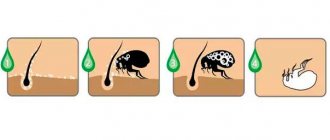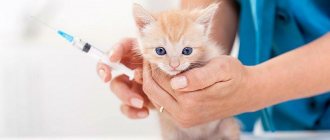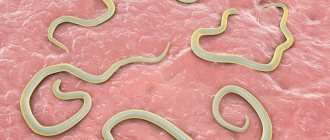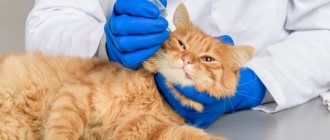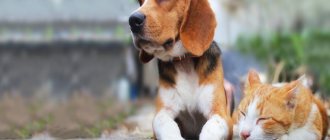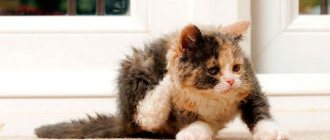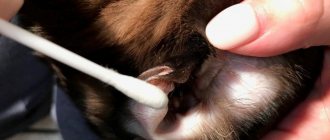Methods of flea infestation
Most often, an animal becomes infected on the street, but even a domestic cat that has never left the apartment and has not been in contact with sick animals can become a victim of blood-sucking insects.
The main factor is the presence of eggs laid by fleas, which the owner himself can bring into the house, for example, on the sole of a shoe.
Close-up view of a flea.
Reasons for appearance
A comfortable temperature for the life of parasitic insects is from 20 to 30 degrees. Therefore, they can live in the basements of apartment buildings, and from there move into the entrances and apartments. Consequently, not only street animals, but also those living with people can “catch” these parasites.
The main ways fleas appear in domestic cats are:
- introduction of larvae or adults from the street on clothing and shoes;
- transmission from another mammal that has these parasites (dogs, mice, rats, etc.). It is worth noting that when living outside the city and keeping livestock, the infection rate increases tenfold.
Important: parasitic insects can live on all pets, so without treatment (or if it is not carried out regularly), cross-infection is possible. They do not live on humans, but they can bite.
Pros and cons of using drops
In veterinary medicine, such a flea remedy as drops is common. Their advantages:
- ease of use;
- versatility - the drops additionally protect the cat from ticks, lice, lice and helminths;
- effectiveness - repeated prophylaxis should be carried out after 2-3 months (for each drug, the duration of action is indicated in the instructions).
Disadvantages of drops:
- most products are contraindicated in kittens under 12 weeks of age and pregnant cats;
- toxicity - at least 2-3 days must pass from the last bath of the animal until treatment with drops, so that a protective fat layer has time to form.
Applying drops to the cat's fur.
Overdose
Poisoning of dogs and cats with flea drops is extremely rare (3-5% of cases); the risk group includes sick, elderly, weakened animals, puppies and kittens.
Symptoms:
- drooling, increased sweating;
- vomiting (more often in dogs), nausea, diarrhea;
- uncontrolled eye movements, constriction of the pupils;
- trembling, shortness of breath, lethargy;
- frequent urination, fecal incontinence.
At the first manifestation of alarming symptoms, it is necessary to show the animal to a veterinarian. If it is not possible to do this immediately, you should give your pet a sorbent (activated carbon) to drink. Dosage: 1 tablet per 10 kilograms of weight. Plain water will help alleviate the severity of intoxication; it should be poured into the mouth every 15 minutes, 5-10 milliliters. There is no point in gastric lavage or enema - the drops are absorbed through the skin. If the condition worsens or dangerous symptoms increase (convulsions, shortness of breath), a visit to the clinic is essential to avoid the death of the animal. In a hospital setting, the doctor administers intramuscular or intravenous steroids to eliminate allergic manifestations, and prescribes IVs to promptly remove toxins, which improves the condition of the animal.
Flea drops are the drugs of choice for protection against blood-sucking parasites. They are effective, safe and affordable. The main thing is to adhere to simple rules: strictly adhere to the dosage, frequency and application technology. To enhance the effectiveness of the drops, it is recommended to use an anti-flea collar as an additional means.
At what age are flea drops used?
Almost all drugs are intended for cats aged 2-3 months, but there are also safe drops that can be used for treatment earlier.
Some cat drops suitable for pregnant and lactating cats are contraindicated for kittens. Therefore, to avoid harming the animal, read the package insert.
Frequency of treatment of kittens
To prevent the appearance of fleas, prevention is required once a quarter. If a kitten is infested with fleas, it should be treated with antiparasitic medication immediately.
Effective drops work instantly, killing blood-sucking insects from the first minutes of contact with the pet’s body.
Rules for handling pets
Before using drops, you must read the instructions for their use. The instructions contain information about indications, contraindications and precautions.
It is important to apply the drops not to the fur, but to dry skin without damage. Application area: near the back of the head (withers).
Standard rules for handling domestic cats:
- When applying the medicine, do not allow it to come into contact with the skin.
- After treating the animal, even if the drug was in ampoules, wash your hands thoroughly.
- In order to achieve maximum effect and be able to quickly identify adverse reactions, the kitten should be supervised for the first 2-3 hours.
- If your pet must be left alone, put a veterinary cone on him.
Methods of applying the drug.
Precautionary measures
The peak of toxicity, when the drops act, occurs on the first day. Therefore, it is forbidden to pet the animal and allow it near children.
If a treated cat accidentally comes into contact with human skin, rinse the area with plenty of water. Avoid contact with mucous membranes and affected areas of the skin.
Review of popular drugs
Manufacturers offer a wide range of anti-flea liquids. Let's get acquainted with the most popular drugs.
| Beaphar | Good product from a Dutch manufacturer. Available in different versions - for adults, pregnant/lactating females, kittens and animals weakened by disease. The poisonous base in Beaphar is margosa extract, which kills fleas but is safe for furry pets. And if he licked the liquid, he would not be able to get poisoned. The processing period is one month. Then a new portion is rubbed into the withers. |
| Hartz | The active ingredient of the product is methoprene. Allowed for kittens starting from four months of age. Available in tubes. The line of the spine needs to be treated. The fleas die within 24 hours. |
| Frontline | “Works” simultaneously against fleas and worms. In babies it is used from the ninth week of life. For large cats, you can only take pipettes with a volume of 0.5 ml. |
| Advantage 40 | Active substance imidacloprid. It is applied to the withers and protects the animal for a month. It can be used in nine-month-old babies. |
| Leopard | The popular drug is a Russian development and does not contain insecticides and acaricides used to treat cattle. Despite its budget, Bars is in no way inferior to its foreign counterparts, and sometimes even superior in efficiency. Bars causes an allergic reaction extremely rarely. |
| Celandine | Active against fleas and ticks. “Clandestine” can be practiced on adult cats and dogs, as well as cubs, starting from the age of eight weeks. It is quite toxic and, when licked, can cause poisoning and a severe allergic reaction. |
| Dana | Available in plastic pipettes. "Dana" is effective against fleas, ticks and lice. The duration of action is long - within several weeks the pet will be completely protected. |
| Advocate | The active substances are imidacloprid and moxidectin. The first destroys fleas and worms. The product will be effective for four weeks after application. Accidentally exceeding the recommended dosage does not pose a danger. It is allowed to use “Advocate” from the ninth week of a purr’s life. |
| Stonghold / Stronghold | “Works” comprehensively. Recommended for killing fleas, ticks, worms and some other parasites. Safe, approved for use in one and a half month old babies and during pregnancy in females. “Stronghold” is used to treat the hair of the withers; there is no need to rub it in. The maximum concentration of the substance is recorded after 24 hours. |
| Rolf Club | The product provides three-level protection. Effective against nine ectoparasites and flying blood-sucking insects. It is allowed to use starting from the 12th week of a cat’s life. Contraindicated during pregnancy. |
| Inspector | The composition contains two insecticides - fipronil and moxidectin. Effective against flea and lice infestations. Can be used from seven weeks of age, as well as in pregnant/lactating females. After application, do not bathe the animal for four days. |
| Barsik | The solution is from a Ukrainian manufacturer. |
What is better drops or a flea collar? This should be decided by the owner of the cat living in his apartment. There are no specific recommendations.
If the drops do not help, then most likely the cat was caught in the rain and they were washed away. In this case, the processing can be repeated.
How long before you can wash after applying drops?
The period before washing a cat after flea treatment depends on the composition of the product used. It takes 1-2 days for a water-based product to absorb, and about 5 days for an oil-based product.
If you notice allergy symptoms (itching, redness, fresh scratching), your cat should be bathed immediately. A local reaction to the use of the drug can cause irreversible consequences that will require urgent treatment of the animal.
In order not to harm the cat and to be sure that the necessary protective layer has been formed, it is recommended to use the drops 2-3 days after bathing. In some cases, this period is 5 days.
What affects the effectiveness of the drops?
First of all, the effectiveness of using drops depends on the correct choice of drug and accurate dosage. It is also important to follow the rules of application, as well as adherence to safety measures.
However, just applying drops to the withers is not enough. It is necessary to clean and treat the room where the pet lives and especially its place - bed, house. The most effective way is to wash the floors with an anti-flea agent and treat carpeting, baseboards, cracks and pet bedding with an anti-flea spray.
What happens to fleas after treatment?
Drops have a detrimental effect on parasites in one of three ways:
- Impact on the nervous system, resulting in death.
- Contact action. A toxic substance with a poisonous effect penetrates the insect’s body through direct contact.
- Repellent effect. The smell of some products can only repel fleas, but will not lead to their destruction.
Protection from parasites.
Prevention
To prevent the appearance of fleas in a cat, you can use some of the remedies listed above. For example, periodic washing with shampoo and soap or wearing a special collar.
In addition, it is necessary to take into account that the sleeping place of an infected animal (bedding, floor, carpet) is also inhabited by parasites. Therefore, the cat should be treated and its bed disinfected at the same time. This is important to prevent the risk of re-infection.
Disinfection of the premises where the animal lives is also mandatory. It can be done using special products sold in pet stores. It is necessary to treat not only the floor, but also upholstered furniture, curtains, and baseboards. If it is difficult to do this yourself, then it is worth inviting disinfection specialists.
Among the folk recipes for prevention, you can use the effective method of repelling insects with wormwood. To do this, place dry or fresh branches of the plant under the bedding on the sleeping area.
On a note
: washing the floor with a strong decoction of wormwood will help prevent the appearance of parasitic insects in an apartment or private house if treating the floor with disinfectants is impossible for some reason. For example, if there is an allergy sufferer in the family or a baby who is still learning the world at a crawl.
Fleas on a cat are not forever. This problem can and should be solved promptly, without leading to serious ailments. Experienced veterinarians at the Jungle Clinic will help treat your four-legged pet, regardless of the severity of the clinical case.
What to do if drops don’t help
Flea medications may not be effective in the following situations:
- The medicine was chosen incorrectly.
- Application rules not followed.
- The dosage was calculated incorrectly.
- The date of preventative treatment has been missed.
- The drug is used after the expiration date.
If you have treated your cat according to the instructions, but there is no effect, contact a veterinary clinic for help.
Veterinarian help.
Security measures
When applying flea drops and for the first time after the procedure, you must follow the following safety precautions:
- carefully ensure that the drops do not get on the mucous membranes or in the mouth of both the pet and the owner;
- apply the drug with gloves, then wash your hands thoroughly and dispose of the pipette or tube;
- do not eat, drink or smoke during the procedure;
- For the first 24 hours after applying the drops, do not pet your pet and do not allow small children or pets near it.
No ironing
Attention! If the drug is used for the first time, it is necessary to carefully monitor the pet’s condition in order to notice an allergic reaction in time.
Injections for cats
The withers are also used to give injections to sick cats. After all, subcutaneous injections are less painful than intramuscular injections. In addition, the medicine injected under the skin is absorbed into the blood faster. The skin in the withers area is more elastic than in other places, so the pain will be less. Also, when exposed to this area of the body, the animal shows obedience, which is why injections are given to cats in the area of the withers.
It is best to give the injection not alone, but with a person who will help put the cat down. The pet should be placed on its side, with its back to the person injecting. Grabbing the cat by the withers, insert the needle parallel to the back. In this case, you need to pull the skin of the withers up a little so that the reflex works and the pet calms down.
If one person will give the injection, then it will be better to sit the cat on a flat surface and let the cat take a horizontal position, pulling the skin with his left hand, give him an injection, as shown in the photo. The needle must be inserted exactly a third of the way - no more can be inserted, as this can be dangerous for the animal. In this case, only a small syringe is used, but an insulin syringe is allowed.
